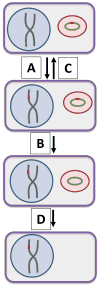Horizontal gene transfer between bacteria and animals
- PMID: 21334091
- PMCID: PMC3068243
- DOI: 10.1016/j.tig.2011.01.005
Horizontal gene transfer between bacteria and animals
Abstract
Horizontal gene transfer is increasingly described between bacteria and animals. Such transfers that are vertically inherited have the potential to influence the evolution of animals. One classic example is the transfer of DNA from mitochondria and chloroplasts to the nucleus after the acquisition of these organelles by eukaryotes. Even today, many of the described instances of bacteria-to-animal transfer occur as part of intimate relationships such as those of endosymbionts and their invertebrate hosts, particularly insects and nematodes, while numerous transfers are also found in asexual animals. Both of these observations are consistent with modern evolutionary theory, in particular the serial endosymbiotic theory and Muller's ratchet. Although it is tempting to suggest that these particular lifestyles promote horizontal gene transfer, it is difficult to ascertain given the nonrandom sampling of animal genome sequencing projects and the lack of a systematic analysis of animal genomes for such transfers.
Copyright © 2011 Elsevier Ltd. All rights reserved.
Figures


References
Publication types
MeSH terms
Grants and funding
LinkOut - more resources
Full Text Sources
Other Literature Sources

